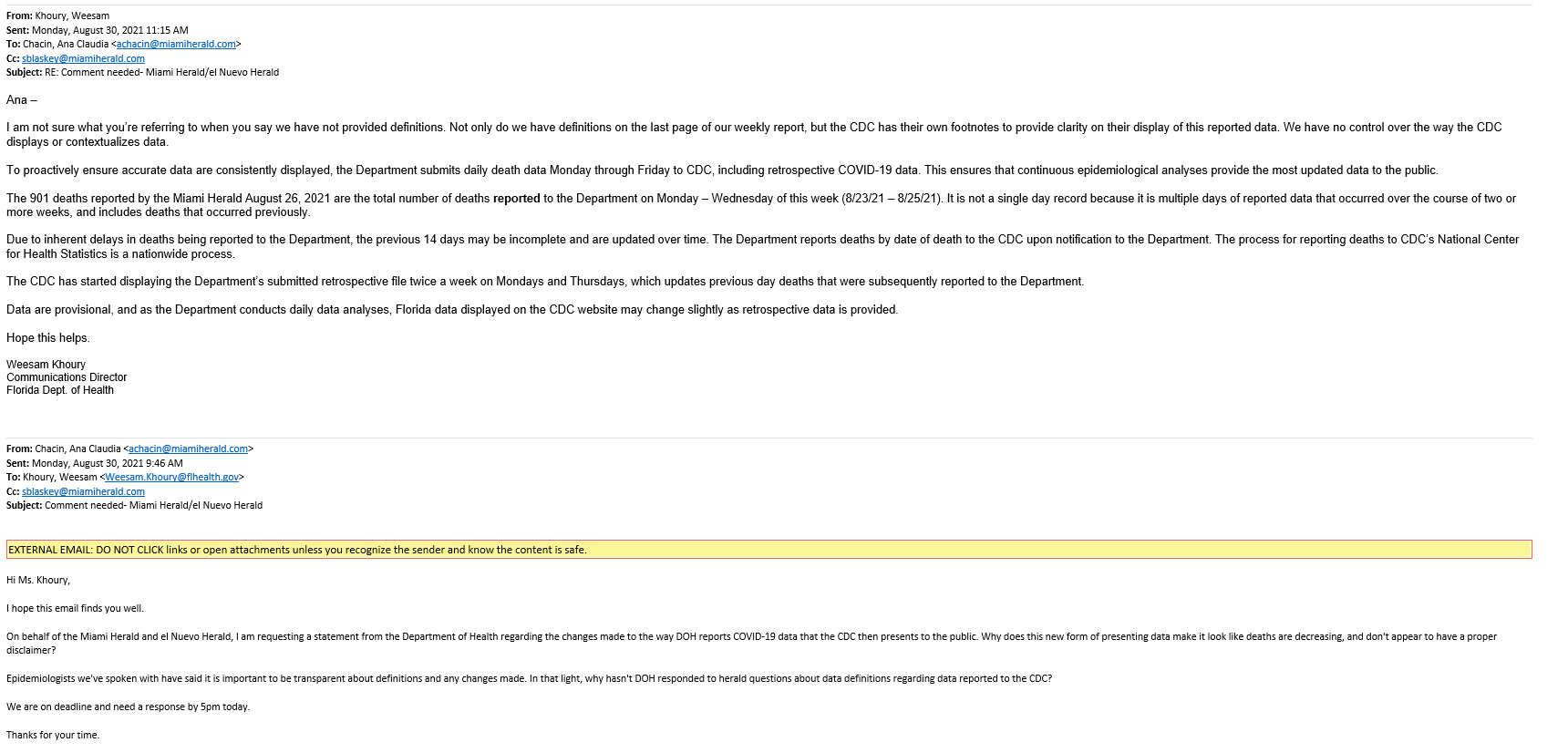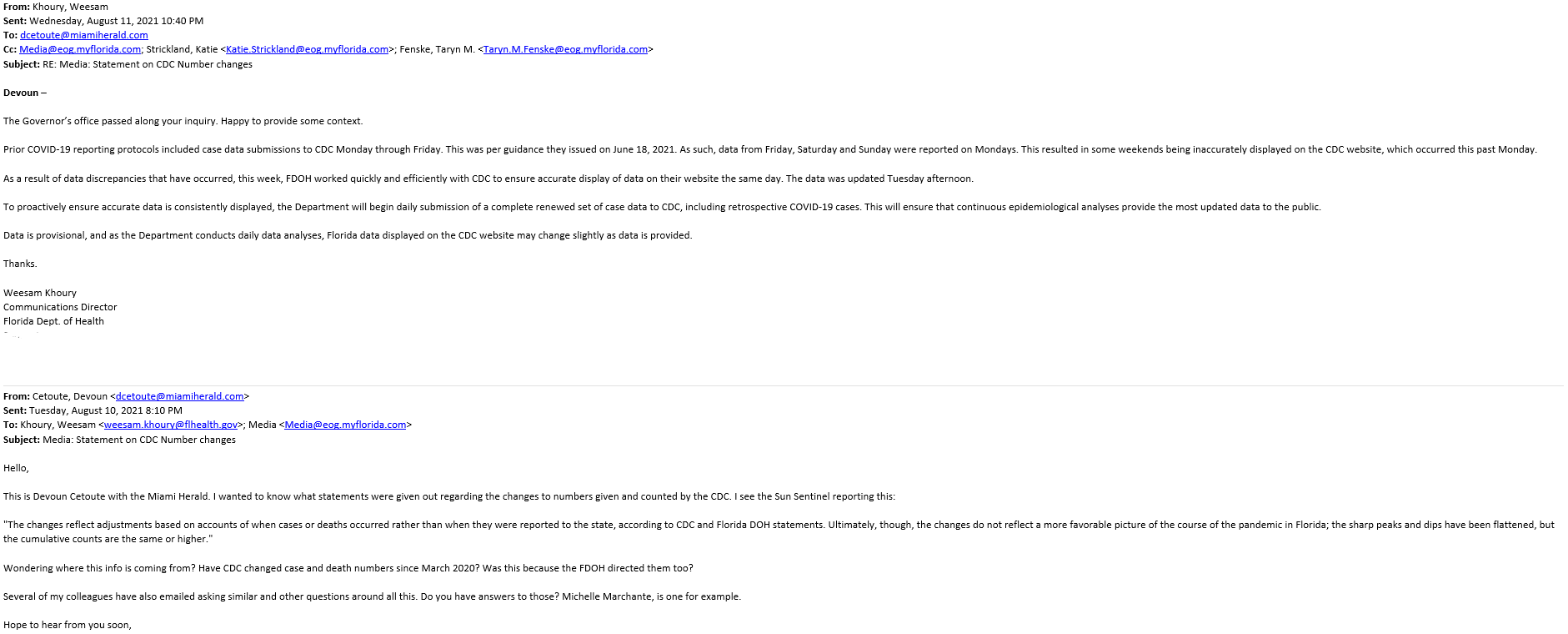It's a New Day in Public Health.
The Florida Department of Health works to protect, promote, and improve the health of all people in Florida through integrated state, county, and community efforts.
Florida Department of Health Sets the Record Straight on False Data Claims by the Miami Herald
August 31, 2021
Contact:
Communications Office
NewsMedia@flhealth.gov
850-245-4111
Tallahassee, Fla. — Today, the Miami Herald published an article riddled with contradictions and false claims – specifically in regards to their front page headline: “Florida changed its COVID-19 data, creating an ‘artificial decline’ in recent deaths.”
The Miami Herald also published a misleading article on Friday, August 27, stating:
“It is the largest single-day increase to the death total in the state’s COVID pandemic history… The jump in the number of reported cases and deaths is due to the newest way deaths and cases are counted. The CDC implemented the change earlier this month, causing occasional one-day aberrations like the 901 additional deaths on Thursday and 726 more deaths reported Monday.”
These narratives surrounding “artificial decline” and “jump” contradict one another, are patently false, and have zero credibility. The Department of Health welcomes the opportunity to highlight these contradictions and falsehoods.
COVID-19, and public health in general, should never be politicized. Publications like the Miami Herald have a duty to their readers, and to all Floridians, to report on the pandemic in a factual and objective manner.
Myths vs. Facts
Myth: “ Florida changed its COVID-19 data, creating an ‘artificial decline’ in recent deaths”
Fact: This is completely incorrect and misleads the public. Florida reports COVID-19 deaths by date of death for precision, accuracy, and transparency in public communications. As stated in the article itself from an epidemiologist:
“Deaths by date of death curve is the most accurate you can get,” Salemi said. “You know exactly when people died, you know how to construct the curve and exactly when we were experiencing surges in terms of deaths.”
Updating already provisional data does not create an “artificial decline,” nor does it distort the data. These are the deaths as they occurred by date. The fact that these data are provisional is made clear by both DOH reports and the data displayed by the CDC. This ensures that the most accurate data are provided to the public. As the Miami Herald article reported, many other states report COVID-19 deaths the same way Florida does.
This month, the Department worked to develop a procedural improvement with CDC to ensure the most accurate data is consistently provided to the public. The Department has reported deaths by date of death to the CDC since March. This information comes from numerous sources, including labs, medical examiners, hospitals, and physicians. All deaths are required to be filed with the Department’s Bureau of Vital Statistics to ensure verification and accuracy. This reporting process is epidemiologically sound and is not unique to COVID-19.
Myth: “ The change came the day after the state health department’s official Twitter account posted a series of late-night tweets accusing the CDC of publishing incorrect numbers, but offering little explanation.
“The health department did not acknowledge the subsequent change in the data structure or its abrupt onset, leaving the public scrambling for answers as more than a year’s worth of data changed from one day to the next....
“At first, the data on the CDC website was updated in a largely predictable manner, similar to the way that the DOH had reported daily changes throughout the pandemic. Then on Aug. 10, without warning or any explanation from the health department or the CDC, the data for nearly every day of the previous year changed. Neither agency immediately explained the changes.”
Fact: DOH provided multiple reporters, including those involved in recently published news stories, statements explaining this process, and provided clarity on Twitter – the same medium on which this misinformation was perpetuated.
Myth: “ The Herald also found that during the last two surges the trend lines using date of death showed peaks 25% and 8% percent higher respectively than the corresponding peaks by report date.”
Fact: Miami Herald admits there are fluctuations, both increasing and decreasing. This contradicts their own misleading narrative claiming “distorted and artificial declines.”
Myth: “ The DOH weekly report notes “death counts include individuals who meet a standardized national surveillance case definition” but includes no descriptions of how the health department presents the numbers.”
Fact: This is not true. Please reference the clearly labeled chart available on every report.
Myth: “When numbers are presented in a flattering light, an expert will generally be able to see through the dazzle quite quickly,” Harford said. “That said, I still think the truthful-yet-deceptive framing of numbers is a serious problem.
“When data are subtly distorted or presented differently than expected — something Harford called “statistical sleight of hand” — it can prompt dangerous levels of general mistrust and cynicism, he said.”
Fact: Epidemiologists do not rely on “flattery,” and this disregards the hard work of thousands of public health professionals that have worked around the clock for over 500 days. The data are the data.
As many epidemiologists and informed health professionals would know, there is an inherent lag when deaths are reported to the Department from external sources. That is why relying on date of death, rather than date reported, is the most accurate representation of COVID-19 trends and surveillance. Again, to reiterate:
“Deaths by date of death curve is the most accurate you can get,” Salemi said. “You know exactly when people died, you know how to construct the curve and exactly when we were experiencing surges in terms of deaths.”
About the Florida Department of Health
The department, nationally accredited by the Public Health Accreditation Board, works to protect, promote and improve the health of all people in Florida through integrated state, county and community efforts.
Follow us on Facebook, Instagram and Twitter at @HealthyFla. For more information about the Florida Department of Health please visit www.FloridaHealth.gov.






Connect with DOH